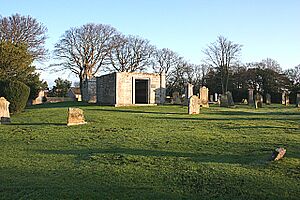Holy Trinity Church, Spynie facts for kids
Quick facts for kids Holy Trinity, Spynie |
|
|---|---|

The site of the church in the graveyard at Spynie
|
|
| Location | Spynie, Moray |
| Country | Scotland |
| Denomination | Catholic |
| History | |
| Authorising papal bull | 7 April 1206 |
| Founded | 1207 |
| Founder(s) | Bishop Brice de Douglas |
| Dedication | The Holy Trinity |
| Architecture | |
| Functional status | Ruin |
| Architectural type | Cathedral |
| Administration | |
| Diocese | Moray |
Holy Trinity Church, Spynie, was an important church in Spynie, Moray, a region in north-east Scotland. For many years, until 1735, it was the main church for the local area, known as a parish church. It also served as the main church, or cathedral, for the Diocese of Moray from 1207 to 1224.
Today, you can't see any part of the old church building. However, its graveyard is still there, close to Spynie Palace. Two burial vaults now stand where the church once was. A cross marks the spot where the church's eastern end used to be. This graveyard is also the resting place of Ramsay MacDonald, who was once the Prime Minister of Britain.
Contents
History of Holy Trinity Church
The church at Spynie has a long history, possibly dating back even before the 12th century. In early times, the Bishops of Moray did not have one fixed main church. They moved between churches in Spynie, Birnie, and Kinneddar.
Early Church Agreements
Between 1172 and 1174, King William the Lion made an agreement with Bishop Simon de Tosny. The King agreed to give all his "teinds" (a type of tax, usually one-tenth of income) from the Diocese of Moray to the Holy Trinity church. This was for the benefit of the bishopric of Moray and Bishop Simon.
Bishop Simon also made a similar agreement with Freskin of Duffus Castle. This agreement was about the woods and mosses in Spynie and Findrassie. Later, Bishop Simon's agreement with the King was confirmed by the next bishop, Richard de Lincoln, in 1187 and 1199. However, Bishop Richard chose Kinneddar as his main church and began to set up its rules.

Spynie Becomes a Cathedral
The main church of the Moray region was moved from Kinneddar to Spynie by Bishop Richard's successor, Bricius de Douglas. This was part of a big change to how the diocese was organized.
In 1207, Pope Innocent III issued a special order called a papal bull. This order confirmed Spynie as the new seat of the cathedral. The decision was made because Spynie was a good location for managing the diocese. It was also not in a dangerous or exposed area.
A new set of rules was introduced for the church, similar to those at Lincoln Cathedral. These rules created a small group of eight church leaders, called a chapter. This group included important roles like a dean, a precentor (who led the singing), a treasurer, a chancellor, and an archdeacon.
Moving the Cathedral to Elgin
We don't know how much of Bishop Bricius's cathedral at Spynie was built before he died in 1222. However, on July 19, 1224, the next bishop, Andreas de Moravia, moved the main church again. This time, it moved about 3 kilometers (1.9 miles) south to Elgin.
Bishop Andreas explained that Spynie was too open to dangers from war. He also said it was isolated and difficult to supply with everything needed for church services. The money set aside for building and maintaining the church at Spynie was also moved to Elgin.
Even though the main church moved, Spynie remained the local parish church. It also became a "prebend" of Elgin cathedral, meaning it was linked to it and provided income. Spynie Palace nearby also stayed as the Bishop's main home.
The End of the Old Church
The main church for the parish of Spynie moved to New Spynie in 1745. A new church was built there in 1736. Some of the stones from the old Holy Trinity Church were used to build the new one.
The last part of the old church that remained was a gothic gable (a triangular wall section). This gable fell down in 1850. In 1924, the church's foundations were found. They showed a small church building, about 23 meters (75 feet) long and 10.5 meters (34 feet) wide. Most of the structure, except for the eastern gable, was built simply using clay.

